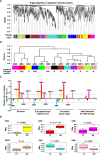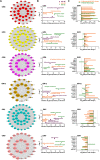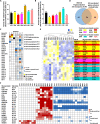Integrative glycoproteomics reveals protein N-glycosylation aberrations and glycoproteomic network alterations in Alzheimer's disease
- PMID: 33008897
- PMCID: PMC7852392
- DOI: 10.1126/sciadv.abc5802
Integrative glycoproteomics reveals protein N-glycosylation aberrations and glycoproteomic network alterations in Alzheimer's disease
Abstract
Protein N-glycosylation plays critical roles in controlling brain function, but little is known about human brain N-glycoproteome and its alterations in Alzheimer's disease (AD). Here, we report the first, large-scale, site-specific N-glycoproteome profiling study of human AD and control brains using mass spectrometry-based quantitative N-glycoproteomics. The study provided a system-level view of human brain N-glycoproteins and in vivo N-glycosylation sites and identified disease signatures of altered N-glycopeptides, N-glycoproteins, and N-glycosylation site occupancy in AD. Glycoproteomics-driven network analysis showed 13 modules of co-regulated N-glycopeptides/glycoproteins, 6 of which are associated with AD phenotypes. Our analyses revealed multiple dysregulated N-glycosylation-affected processes and pathways in AD brain, including extracellular matrix dysfunction, neuroinflammation, synaptic dysfunction, cell adhesion alteration, lysosomal dysfunction, endocytic trafficking dysregulation, endoplasmic reticulum dysfunction, and cell signaling dysregulation. Our findings highlight the involvement of N-glycosylation aberrations in AD pathogenesis and provide new molecular and system-level insights for understanding and treating AD.
Copyright © 2020 The Authors, some rights reserved; exclusive licensee American Association for the Advancement of Science. No claim to original U.S. Government Works. Distributed under a Creative Commons Attribution NonCommercial License 4.0 (CC BY-NC).
Figures






Similar articles
-
Multilayered N-Glycoproteome Profiling Reveals Highly Heterogeneous and Dysregulated Protein N-Glycosylation Related to Alzheimer's Disease.Anal Chem. 2020 Jan 7;92(1):867-874. doi: 10.1021/acs.analchem.9b03555. Epub 2019 Dec 19. Anal Chem. 2020. PMID: 31751117
-
In-depth Site-specific Analysis of N-glycoproteome in Human Cerebrospinal Fluid and Glycosylation Landscape Changes in Alzheimer's Disease.Mol Cell Proteomics. 2021;20:100081. doi: 10.1016/j.mcpro.2021.100081. Epub 2021 Apr 20. Mol Cell Proteomics. 2021. PMID: 33862227 Free PMC article.
-
N-glycoproteomics reveals distinct glycosylation alterations in NGLY1-deficient patient-derived dermal fibroblasts.J Inherit Metab Dis. 2023 Jan;46(1):76-91. doi: 10.1002/jimd.12557. Epub 2022 Oct 4. J Inherit Metab Dis. 2023. PMID: 36102038 Free PMC article.
-
Tools and techniques for quantitative glycoproteomic analysis.Biochem Soc Trans. 2024 Dec 19;52(6):2439-2453. doi: 10.1042/BST20240257. Biochem Soc Trans. 2024. PMID: 39656178 Review.
-
Critical considerations in N-glycoproteomics.Curr Opin Chem Biol. 2023 Apr;73:102272. doi: 10.1016/j.cbpa.2023.102272. Epub 2023 Feb 7. Curr Opin Chem Biol. 2023. PMID: 36758418 Review.
Cited by
-
Glycoproteomics Landscape of Asymptomatic and Symptomatic Human Alzheimer's Disease Brain.Mol Cell Proteomics. 2022 Dec;21(12):100433. doi: 10.1016/j.mcpro.2022.100433. Epub 2022 Oct 27. Mol Cell Proteomics. 2022. PMID: 36309312 Free PMC article.
-
Heparan sulfate proteoglycan in Alzheimer's disease: aberrant expression and functions in molecular pathways related to amyloid-β metabolism.Am J Physiol Cell Physiol. 2023 Apr 1;324(4):C893-C909. doi: 10.1152/ajpcell.00247.2022. Epub 2023 Mar 6. Am J Physiol Cell Physiol. 2023. PMID: 36878848 Free PMC article. Review.
-
A New Strategy for High-Efficient Tandem Enrichment and Simultaneous Profiling of N-Glycopeptides and Phosphopeptides in Lung Cancer Tissue.Front Mol Biosci. 2022 May 24;9:923363. doi: 10.3389/fmolb.2022.923363. eCollection 2022. Front Mol Biosci. 2022. PMID: 35685241 Free PMC article.
-
Glycosylation alterations in serum of Alzheimer's disease patients show widespread changes in N-glycosylation of proteins related to immune function, inflammation, and lipoprotein metabolism.Alzheimers Dement (Amst). 2022 Apr 27;14(1):e12309. doi: 10.1002/dad2.12309. eCollection 2022. Alzheimers Dement (Amst). 2022. PMID: 35496372 Free PMC article.
-
New insight into protein glycosylation in the development of Alzheimer's disease.Cell Death Discov. 2023 Aug 25;9(1):314. doi: 10.1038/s41420-023-01617-5. Cell Death Discov. 2023. PMID: 37626031 Free PMC article. Review.
References
-
- Scheltens P., Blennow K., Breteler M. M., de Strooper B., Frisoni G. B., Salloway S., Van der Flier W. M., Alzheimer's disease. Lancet 388, 505–517 (2016). - PubMed
-
- Soejitno A., Tjan A., Purwata T. E., Alzheimer's disease: Lessons learned from amyloidocentric clinical trials. CNS Drugs 29, 487–502 (2015). - PubMed
-
- Narayanan M., Huynh J. L., Wang K., Yang X., Yoo S., McElwee J., Zhang B., Zhang C., Lamb J. R., Xie T., Suver C., Molony C., Melquist S., Johnson A. D., Fan G., Stone D. J., Schadt E. E., Casaccia P., Emilsson V., Zhu J., Common dysregulation network in the human prefrontal cortex underlies two neurodegenerative diseases. Mol. Syst. Biol. 10, 743 (2014). - PMC - PubMed
-
- Sancesario G. M., Bernardini S., Alzheimer's disease in the omics era. Clin. Biochem. 59, 9–16 (2018). - PubMed
Publication types
MeSH terms
Substances
Grants and funding
LinkOut - more resources
Full Text Sources
Other Literature Sources
Medical
Molecular Biology Databases

